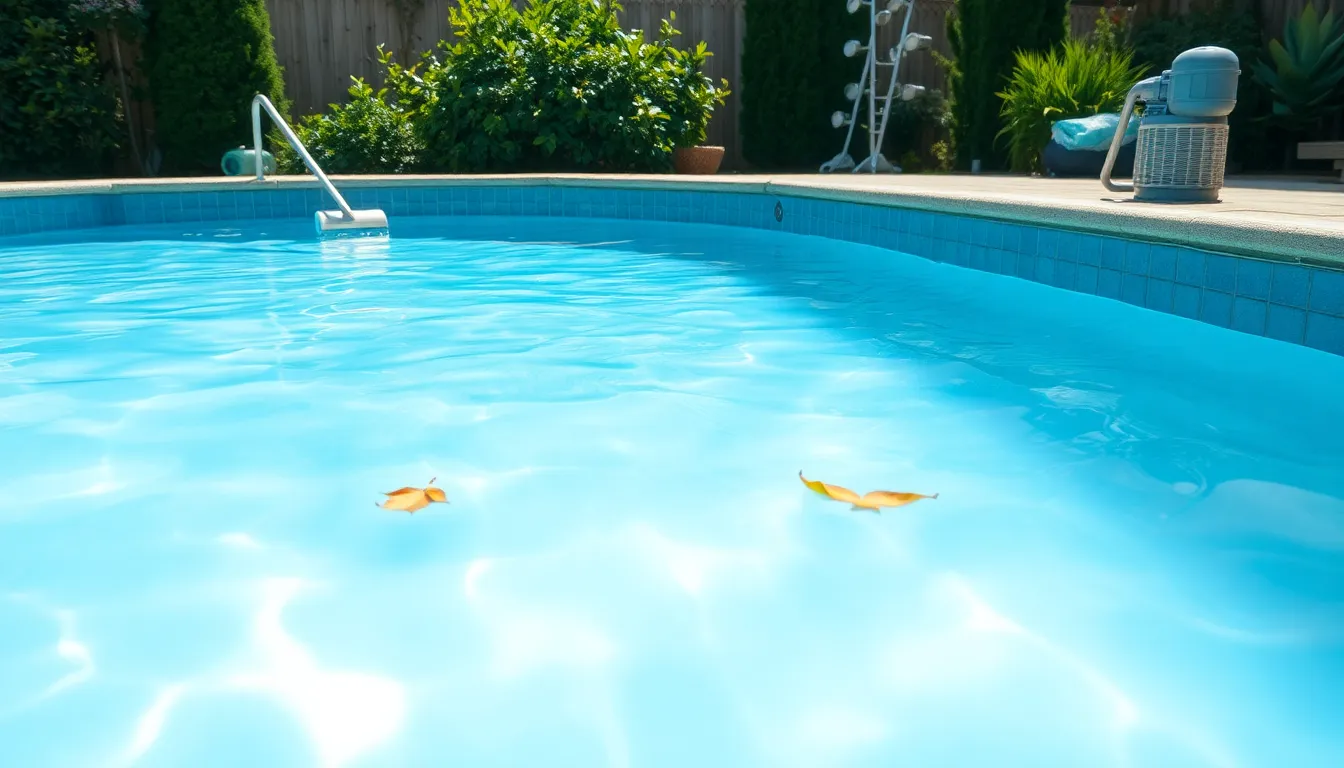Table of Contents
ToggleA cloudy pool can be a real buzzkill. You dive in expecting a refreshing splash only to find yourself swimming through a murky mystery. It’s like diving into a bowl of soup, but not the delicious kind. While you might think your pool is throwing a tantrum, the truth is often less dramatic. The chemicals could be perfectly balanced, leaving you scratching your head in confusion.
So, what gives? Why does a pool with fine chemicals look like a scene from a horror movie? Understanding the culprits behind that cloudiness is key to restoring your backyard oasis. From pesky particles to filtration issues, there’s more to this watery dilemma than meets the eye. Let’s dive into the reasons behind your cloudy pool and how to clear things up without losing your cool.
Understanding Cloudy Pool Water
Cloudiness in pool water often arises from a variety of factors, despite having balanced chemicals. Tiny particles suspended in the water can create a hazy appearance. Excessive debris, such as leaves or dirt, typically contributes to these particles. While chlorine and pH levels may remain within proper ranges, other issues can still lead to visual problems.
Filtration plays a crucial role in maintaining water clarity. A malfunctioning or inadequate filter may fail to remove suspended solids effectively. Regularly checking and cleaning the pool filter helps ensure optimal performance. Inadequate circulation can result from incorrect pump size or placement. Proper water flow is essential for keeping the pool free from cloudiness.
Algae growth also leads to murky water. Even if chemicals appear fine, algae can thrive in warm weather despite adequate sanitation levels. It often helps to test for algae presence using specialized test kits. If found, shock treatments or algaecides can treat the water efficiently.
Water chemistry beyond basic sanitization can influence cloudiness. High levels of calcium hardness or total dissolved solids may induce turbidity. Regular water testing can identify these issues, allowing for appropriate adjustments. Flocculants can also clarify pool water quickly by binding particles together for easier removal through filtration.
Environmental factors contribute to pool water cloudiness too. Rainfall, wind, and nearby landscaping might introduce impurities into the pool. Controlling the surrounding environment reduces the likelihood of external debris affecting water clarity. Routine maintenance practices, including skimming and brushing, help maintain the pool’s appearance and hygiene.
Common Causes of Cloudy Pool Water
Cloudy pool water can stem from several common issues, even when chemical levels appear balanced. Understanding these causes helps in addressing the problem effectively.
Poor Filtration
Filtration problems often play a major role in pool cloudiness. Inefficient filters struggle to remove debris and particles from the water. A clogged filter can lead to inadequate circulation, allowing contaminants to linger. Additionally, filter types such as sand or cartridge filters may require regular backwashing or replacement to maintain efficiency. Inspecting the filter system and ensuring proper operation is crucial for clarity.
Algae Growth
Algae thrive in warm, humid environments and can quickly cloud pool water. Often, algae growth occurs even when sanitation levels meet expectations. Spotting early signs like green or yellowish tint in the water indicates potential trouble. Shock treatments or algaecides target algae effectively, clearing the water and restoring clarity. Frequent brushing of pool surfaces helps prevent algae buildup before it becomes an issue.
High Total Dissolved Solids
High total dissolved solids (TDS) can contribute to cloudy pool water. TDS includes various impurities like minerals, metals, and organic matter that accumulate over time. Excessive TDS levels hinder sanitizer effectiveness, leading to murky conditions. Regular testing of water quality helps monitor TDS levels. If high, consider draining and refilling a portion of the pool water to restore clarity and balance.
When Chemicals Appear Fine
Testing water remains essential for maintaining pool clarity. Regular analysis of chlorine, pH, total alkalinity, and calcium hardness helps ensure balanced chemistry. Utilizing test strips or liquid kits provides accurate readings; any discrepancies indicate a need for further action. While conventional parameters matter, neglecting less visible factors like total dissolved solids can lead to cloudiness. Assessing these components consistently uncovers issues that might compromise water clarity.
Common misconceptions often impede effective pool maintenance. Many believe clear water indicates safe conditions, which isn’t always true. Ignoring factors affecting clarity, such as inadequate filtration or untested TDS levels, leads to ongoing challenges. Some assume that only high chlorine levels ensure sanitation; however, algae can flourish even under adequate chlorination. Understanding that chemicals appearing fine isn’t an assurance of perfect clarity allows pool owners to take proactive measures against cloudiness.
Solutions for Cloudy Pool Water
Cloudy pool water requires attention to restore clarity. Several solutions exist that can effectively address this issue.
Improving Filtration
To improve water clarity, first check the filtration system. Filters should be cleaned or replaced regularly to ensure efficient debris removal. Inspecting filter pressure gauges can indicate whether it requires maintenance. Regular backwashing helps remove trapped particles from the filter media. Ensuring the filter runs for at least 8 to 12 hours daily increases circulation, preventing cloudiness. Consider upgrading to a more powerful filter if the current one struggles. Replacing sand or cartridge elements can significantly enhance water quality.
Shock Treatments
Using shock treatments can effectively eliminate cloudy water. Shock increases chlorine levels, targeting contaminants and breaking down chloramines. It’s crucial to select a suitable shock product, depending on water conditions. Applying shock during the evening minimizes degradation from UV light. Follow the manufacturer’s instructions for dosage based on pool size. Allowing the pump and filter to run for several hours after application ensures proper distribution. Routine shock treatments can prevent algae growth and maintain sparkle. Regularly incorporating this practice enhances overall pool sanitation.
Prevention Tips for Clear Pool Water
Regular testing of pool water ensures clarity. Check chlorine, pH, total alkalinity, and calcium hardness consistently. High total dissolved solids can contribute to cloudiness, so testing for these levels helps prevent ongoing issues.
Maintaining a clean filtration system is vital. Clean or replace filters as needed, and check pressure gauges regularly. Filters should operate for at least 8 to 12 hours daily to improve circulation. Upgrading to a more powerful filter can enhance water quality significantly.
Wiping down pool surfaces keeps algae at bay. Brush walls and floors frequently to remove any early signs of algae growth. A weekly skimming routine removes debris and prevents contamination, contributing to clearer water.
Shock treatments play a crucial role in maintaining clarity. Applying shock during the evening minimizes UV degradation of chlorine. This tactic allows the treatment to work effectively without interference, especially when targeting contaminants.
Implementing proper water circulation methods further ensures clarity. Positioning return jets to promote circulation improves debris removal. An adjustable schedule for filter operation assists in distributing treated water evenly throughout the pool.
Environmental factors frequently affect water quality. Landscaping and rainfall influence cloudiness by introducing debris and impurities. Addressing these factors promptly aids in maintaining a pristine swimming environment.
Monitoring weather conditions also contributes to clarity management. Anticipate heavy rainfall or debris falls and adjust maintenance accordingly. Being proactive helps prevent cloudiness before it begins.
A cloudy pool can be a frustrating hurdle for pool owners despite having balanced chemicals. Understanding the underlying causes is crucial for restoring clarity and ensuring a pleasant swimming experience. By addressing filtration issues and monitoring water chemistry regularly, they can tackle cloudiness effectively.
Implementing routine maintenance practices such as skimming and brushing will also keep the pool looking its best. Being proactive in testing for algae and adjusting circulation can prevent future cloudiness. With the right approach and consistent care, a sparkling clear pool is well within reach, allowing everyone to enjoy a refreshing dip.







